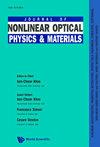Design and simulation of the all-optical XOR logic gate by XPM mechanism using photonic crystal semiconductor optical amplifier based on mach–zehnder interferometer
IF 2.3
4区 物理与天体物理
Q2 OPTICS
Journal of Nonlinear Optical Physics & Materials
Pub Date : 2022-01-28
DOI:10.1142/s0218863522500138
引用次数: 2
Abstract
In the presented structure, the performance of the all-optical XOR logic gate (AO-XOR-LG) is investigated. The XOR-LG is designed and simulated using a photonic crystal semiconductor optical amplifier (PC-SOA) based on Mach–Zehnder interferometer (MZI) and cross-phase modulation (XPM) nonlinear mechanism. The input optical pulse train used in this simulation is the type of RZ (Return-to-Zero). The finite difference method (FDM) has been used to solve the rate and propagation equations. The effect of input signal energy, bias current, and group refractive index on the output signal and gain of the XOR-LG is studied. The optimal mode is obtained for the XOR-LG with a bit rate of 80 Gbps. Furthermore, for the first time, the effects of quality factor (QF), conversion efficiency (CE), extinction ratio (ER), pattern effect (PE), and gain recovery are simultaneously analyzed in the simulation to increase PC-SOA performance. According to the results, PC-SOA has a more reasonable logic performance than conventional SOA, and due to its much shorter length than SOA, it can be a much better choice for integrated optical circuits.利用基于马赫曾德干涉仪的光子晶体半导体光放大器,设计并仿真了基于XPM机制的全光异或逻辑门
在该结构中,研究了全光异或逻辑门(AO-XOR-LG)的性能。采用基于Mach-Zehnder干涉仪(MZI)和交叉相位调制(XPM)非线性机制的光子晶体半导体光放大器(PC-SOA)设计和仿真了XOR-LG。在这个模拟中使用的输入光脉冲序列是RZ(归零)的类型。用有限差分法求解了速率方程和传播方程。研究了输入信号能量、偏置电流和群折射率对XOR-LG输出信号和增益的影响。得到了比特率为80gbps的XOR-LG的最优模式。此外,首次在仿真中同时分析了质量因子(QF)、转换效率(CE)、消光比(ER)、模式效应(PE)和增益恢复对PC-SOA性能的影响。结果表明,PC-SOA具有比传统SOA更合理的逻辑性能,并且由于其长度比SOA短得多,可以成为集成光电路的更好选择。
本文章由计算机程序翻译,如有差异,请以英文原文为准。
求助全文
约1分钟内获得全文
求助全文
来源期刊
CiteScore
3.00
自引率
48.10%
发文量
53
审稿时长
3 months
期刊介绍:
This journal is devoted to the rapidly advancing research and development in the field of nonlinear interactions of light with matter. Topics of interest include, but are not limited to, nonlinear optical materials, metamaterials and plasmonics, nano-photonic structures, stimulated scatterings, harmonic generations, wave mixing, real time holography, guided waves and solitons, bistabilities, instabilities and nonlinear dynamics, and their applications in laser and coherent lightwave amplification, guiding, switching, modulation, communication and information processing. Original papers, comprehensive reviews and rapid communications reporting original theories and observations are sought for in these and related areas. This journal will also publish proceedings of important international meetings and workshops. It is intended for graduate students, scientists and researchers in academic, industrial and government research institutions.

 求助内容:
求助内容: 应助结果提醒方式:
应助结果提醒方式:


